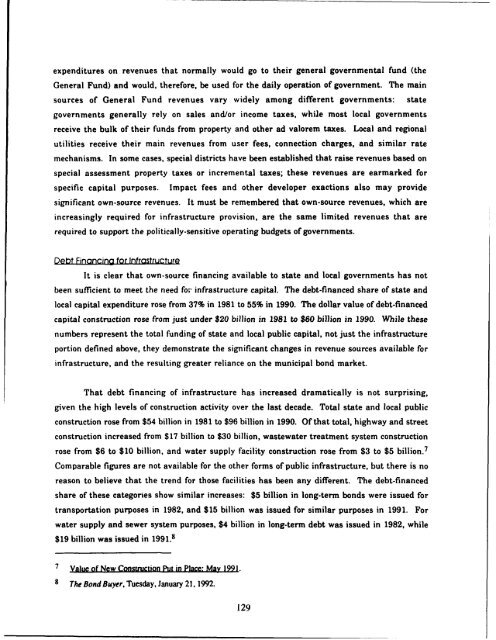Challenges and Opportunities for Innovation in the Public Works ...
Challenges and Opportunities for Innovation in the Public Works ...
Challenges and Opportunities for Innovation in the Public Works ...
Create successful ePaper yourself
Turn your PDF publications into a flip-book with our unique Google optimized e-Paper software.
expenditures on revenues that normally would go to <strong>the</strong>ir general governmental fund (<strong>the</strong><br />
General Fund) <strong>and</strong> would, <strong>the</strong>re<strong>for</strong>e, be used <strong>for</strong> <strong>the</strong> daily operation of government. The ma<strong>in</strong><br />
sources of General Fund revenues vary widely among different governments: state<br />
governments generally rely on sales <strong>and</strong>/or <strong>in</strong>come taxes, while most local governments<br />
receive <strong>the</strong> bulk of <strong>the</strong>ir funds from property <strong>and</strong> o<strong>the</strong>r ad valorem taxes. Local <strong>and</strong> regional<br />
utilities receive <strong>the</strong>ir ma<strong>in</strong> revenues from user fees, connection charges, <strong>and</strong> similar rate<br />
mechanisms. In some cases, special districts have been established that raise revenues based on<br />
special assessment property taxes or <strong>in</strong>cremental taxes; <strong>the</strong>se revenues are earmarked <strong>for</strong><br />
specific capital purposes. Impact fees <strong>and</strong> o<strong>the</strong>r developer exactions also may provide<br />
significant own-source revenues. It must be remembered that own-source revenues, which are<br />
<strong>in</strong>creas<strong>in</strong>gly required <strong>for</strong> <strong>in</strong>frastructure provision, are <strong>the</strong> same limited revenues that are<br />
required to support <strong>the</strong> politically-sensitive operat<strong>in</strong>g budgets of governments.<br />
Debt F<strong>in</strong>anc<strong>in</strong>g <strong>for</strong> Infrastructure<br />
It is clear that own-source f<strong>in</strong>anc<strong>in</strong>g available to state <strong>and</strong> local governments has not<br />
been sufficient to meet <strong>the</strong> need <strong>for</strong> <strong>in</strong>frastructure capital. The debt-f<strong>in</strong>anced share of state <strong>and</strong><br />
local capital expenditure rose from 37% <strong>in</strong> 1981 to 55% <strong>in</strong> 1990. The dollar value of debt-f<strong>in</strong>anced<br />
capital construction rose from just under $20 billion <strong>in</strong> 1981 to $60 billion <strong>in</strong> 1990. While <strong>the</strong>se<br />
numbers represent <strong>the</strong> total fund<strong>in</strong>g of state <strong>and</strong> local public capital, not just <strong>the</strong> <strong>in</strong>frastructure<br />
portion def<strong>in</strong>ed above, <strong>the</strong>y demonstrate <strong>the</strong> significant changes <strong>in</strong> revenue sources available <strong>for</strong><br />
<strong>in</strong>frastructure, <strong>and</strong> <strong>the</strong> result<strong>in</strong>g greater reliance on <strong>the</strong> municipal bond market.<br />
That debt f<strong>in</strong>anc<strong>in</strong>g of <strong>in</strong>frastructure has <strong>in</strong>creased dramatically is not surpris<strong>in</strong>g,<br />
given <strong>the</strong> high levels of construction activity over <strong>the</strong> last decade. Total state <strong>and</strong> local public<br />
construction rose from $54 billion <strong>in</strong> 1981 to $96 billion <strong>in</strong> 1990. Of that total, highway <strong>and</strong> street<br />
construction <strong>in</strong>creased from $17 billion to $30 billion, wastewater treatment system construction<br />
rose from $6 to $10 billion, <strong>and</strong> water supply facility construction rose from $3 to $5 billion. 7<br />
Comparable figures are not available <strong>for</strong> <strong>the</strong> o<strong>the</strong>r <strong>for</strong>ms of public <strong>in</strong>frastructure, but <strong>the</strong>re is no<br />
reason to believe that <strong>the</strong> trend <strong>for</strong> those facilities has been any different. The debt-f<strong>in</strong>anced<br />
share of <strong>the</strong>se categories show similar <strong>in</strong>creases: $5 billion <strong>in</strong> long-term bonds were issued <strong>for</strong><br />
transportation purposes <strong>in</strong> 1982, <strong>and</strong> $15 billion was issued <strong>for</strong> similar purposes <strong>in</strong> 1991. For<br />
water supply <strong>and</strong> sewer system purposes, $4 billion <strong>in</strong> long-term debt was issued <strong>in</strong> 1982, while<br />
$19 billion was issued <strong>in</strong> 1991.8<br />
7 Value of New Construction Put <strong>in</strong> Place: May 1991.<br />
8 The Bond Buyer, Tuesday, January 21, 1992.<br />
129







